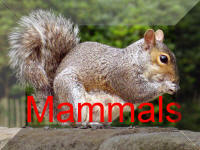The Field Vole (Microtus agrestis)
Back To

Size Head/body length: 90-115mm; tail< 40% of head and body. Weight: 20-40g.
Visit this Link For Pictures Description
Grey-brownYellowy-brown fur. fur above, creamy-grey fur below, rounded snout, less prominent eyes than mice and ears completely covered with fur. Life-span: about one year. Field voles are territorial, active by day and night, are aggressive and each one has its own small territory fiercely defended from other voles. They fight noisily, uttering loud squeaks and angry chattering noises. Can be heard more often than seen.Each vole makes runways amoung the grass stems, usually centered on a tussock where it nests.
Ecology:
Field voles are found throughout mainland Britain and remains date back to before the last glaciation, 9000 years ago. They are absent from a number of island communities including Shetland, the Isle of Man, Isles of Scilly, Lundy and Ireland and are replaced by larger Orkney and Guernsey voles on the respective islands.
DietFood: mainly grasses; also bulbs, roots and tree bark. Occasionally insects, snails and other invertebrates. Found typically in ungrazed grassland or in the early stages of forest plantations but may also live in woodland, hedgerows, dunes, scree or moorland, wherever grass is available. Grass is the field voles' only food source and shredded grass leaves are used to make their nests which are about 10 cm in diameter and may be built at the base of grass tussocks, in underground burrows or even under sheets of corrugated iron.
BreedingBreeding season begins in March/April and ends between October and December. Four or five young are normally found in each litter and females will give birth to five or six litters each year. Four to six young are born in a nest of dry grass, usually hidden in a thick grassy tussock. The babies have grown their fur by ten days old and are weaned at around sixteen days. Young females are ready to mate at six weeks old. Although this gives rise to large numbers, the average life span of a field vole is < 1yr so population turnover is rapid. Voles do not hibernate but moult to cope with the inevitable change in temperature with the seasons. Moulting provides a dense layer of fur for winter and a "lighter" coat in spring.
Like all small mammals, the field vole is host to a number of parasites, carrying fleas and possibly ticks and worms. It must be particularly careful to avoid predators which include kestrels and owls, together with foxes and stoats. The brood size reared by kestrels and owls has been shown to increase as vole numbers increase.
Conservation:Field voles are very widespread and are currently thought to be the most common British mammal; a recent population estimate put the number of field voles in Britain at 75,000,000 and they occur at densities of 100/ha in spring.
Although the field vole is numerous it is still important to consider conservation methods and maintain biodiversity within habitats. Leaving wide field margins under hedgerows will provide cover and food which will encourage and maintain populations. A varied woodland area will encourage small mammals and groups of branches should be left when clearing patches of ground.
Questions:
Where can field voles be observed ?
Voles are more often heard than seen and may be found in grassy areas wherever there is enough grass to support their feeding and living requirements. Travelling about so much in the grass creates well-worn runways and along these you may find characteristic feeding piles of shredded grass and leaves. Field voles live in "covered" areas which provide protection from the weather and predators and a good way to find them is by lifting sheets of corrugated iron which they may choose to nest under.
Do field voles cause damage?
Yes, they do. Field voles are serious pests of young trees in plantation and may chew the bark or completely eat young trees at ground level. This can be prevented by weeding around the area or protecting young trees with plastic tubing.
How do field voles communicate?
Sound and smell . Sight is less important as might be expected for an animal which spends most of its life at ground level in dim light conditions. Field voles particularly use smell as a way of indicating their presence in an area and identifying one another. Large piles of faeces are left at points along their routse and runways which are coated with scent. Smell is used both to attract the opposite sex and to ward off unwanted males in their small teritory
Visit this Link For Pictures
